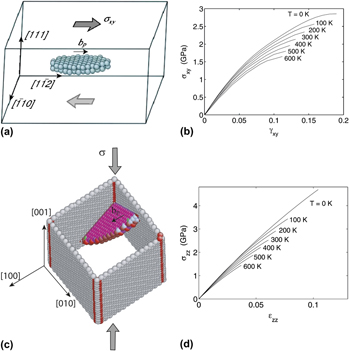Crossref Citations
This article has been cited by the following publications. This list is generated based on data provided by
Crossref.
Pohjonen, Aarne S.
Djurabekova, Flyura
Kuronen, Antti
Fitzgerald, Steven P.
and
Nordlund, Kai
2012.
Analytical model of dislocation nucleation on a near-surface void under tensile surface stress.
Philosophical Magazine,
Vol. 92,
Issue. 32,
p.
3994.
Nordlund, K.
and
Djurabekova, F.
2012.
Defect model for the dependence of breakdown rate on external electric fields.
Physical Review Special Topics - Accelerators and Beams,
Vol. 15,
Issue. 7,
Weinberger, Christopher R.
and
Cai, Wei
2012.
Plasticity of metal nanowires.
Journal of Materials Chemistry,
Vol. 22,
Issue. 8,
p.
3277.
Filleter, Tobin
Ryu, Seunghwa
Kang, Keonwook
Yin, Jie
Bernal, Rodrigo A.
Sohn, Kwonnam
Li, Shuyou
Huang, Jiaxing
Cai, Wei
and
Espinosa, Horacio D.
2012.
Nucleation‐Controlled Distributed Plasticity in Penta‐twinned Silver Nanowires.
Small,
Vol. 8,
Issue. 19,
p.
2986.
Han, Jing
Fang, Liang
Sun, Jiapeng
Han, Ying
and
Sun, Kun
2012.
Length-dependent mechanical properties of gold nanowires.
Journal of Applied Physics,
Vol. 112,
Issue. 11,
Jennings, Andrew T.
Weinberger, Christopher R.
Lee, Seok-Woo
Aitken, Zachary H.
Meza, Lucas
and
Greer, Julia R.
2013.
Modeling dislocation nucleation strengths in pristine metallic nanowires under experimental conditions.
Acta Materialia,
Vol. 61,
Issue. 6,
p.
2244.
Sandoval, Luis A.
Surh, Michael P.
Chernov, Alexander A.
and
Richards, David F.
2013.
Growth of deformation twins in tantalum via coherent twin boundary migration.
Journal of Applied Physics,
Vol. 114,
Issue. 11,
Wen, Mao
Li, Zhiyuan
and
Barnoush, Afrooz
2013.
Atomistic Study of Hydrogen Effect on Dislocation Nucleation at Crack Tip.
Advanced Engineering Materials,
Vol. 15,
Issue. 11,
p.
1146.
Uranagase, Masayuki
and
Matsumoto, Ryosuke
2014.
Thermal activation analysis of enthalpic and entropic contributions to the activation free energy of basal and prismatic slips in Mg.
Physical Review B,
Vol. 89,
Issue. 22,
Ryu, Ill
Cai, Wei
Nix, William D.
and
Gao, Huajian
2015.
Stochastic behaviors in plastic deformation of face-centered cubic micropillars governed by surface nucleation and truncated source operation.
Acta Materialia,
Vol. 95,
Issue. ,
p.
176.
Chen, Lisa Y.
He, Mo-rigen
Shin, Jungho
Richter, Gunther
and
Gianola, Daniel S.
2015.
Measuring surface dislocation nucleation in defect-scarce nanostructures.
Nature Materials,
Vol. 14,
Issue. 7,
p.
707.
Vigonski, Simon
Djurabekova, Flyura
Veske, Mihkel
Aabloo, Alvo
and
Zadin, Vahur
2015.
Molecular dynamics simulations of near-surface Fe precipitates in Cu under high electric fields.
Modelling and Simulation in Materials Science and Engineering,
Vol. 23,
Issue. 2,
p.
025009.
Pizzagalli, Laurent
Brochard, Sandrine
Godet, Julien
and
Gérard, Céline
2015.
Encyclopedia of Nanotechnology.
p.
1.
Saroukhani, S.
Nguyen, L.D.
Leung, K.W.K.
Singh, C.V.
and
Warner, D.H.
2016.
Harnessing atomistic simulations to predict the rate at which dislocations overcome obstacles.
Journal of the Mechanics and Physics of Solids,
Vol. 90,
Issue. ,
p.
203.
Pizzagalli, Laurent
Brochard, Sandrine
Godet, Julien
and
Gérard, Céline
2016.
Encyclopedia of Nanotechnology.
p.
1937.
Ryu, Ill
Cai, Wei
Nix, William D.
and
Gao, Huajian
2016.
Anisotropic Size-Dependent Plasticity in Face-Centered Cubic Micropillars Under Torsion.
JOM,
Vol. 68,
Issue. 1,
p.
253.
Ramachandramoorthy, Rajaprakash
Gao, Wei
Bernal, Rodrigo
and
Espinosa, Horacio
2016.
High Strain Rate Tensile Testing of Silver Nanowires: Rate-Dependent Brittle-to-Ductile Transition.
Nano Letters,
Vol. 16,
Issue. 1,
p.
255.
Kotrechko, S.
Ovsjannikov, O.
Stetsenko, N.
Mikhailovskij, I.
Mazilova, T.
and
Starostenkov, M.
2016.
Yield strength temperature dependence of tungsten nanosized crystals: experiment and simulation.
Philosophical Magazine,
Vol. 96,
Issue. 5,
p.
473.
Gao, Yanfei
and
Bei, Hongbin
2016.
Strength statistics of single crystals and metallic glasses under small stressed volumes.
Progress in Materials Science,
Vol. 82,
Issue. ,
p.
118.
Guziewski, Matthew
Yu, Hang
and
Weinberger, Christopher R.
2016.
Multiscale Materials Modeling for Nanomechanics.
Vol. 245,
Issue. ,
p.
373.
